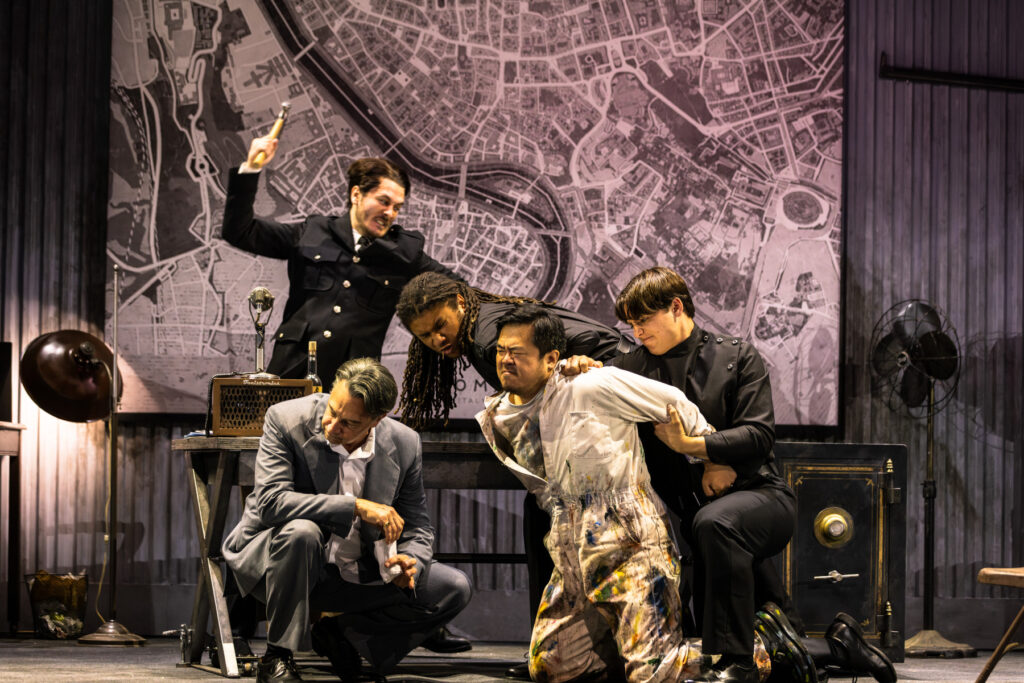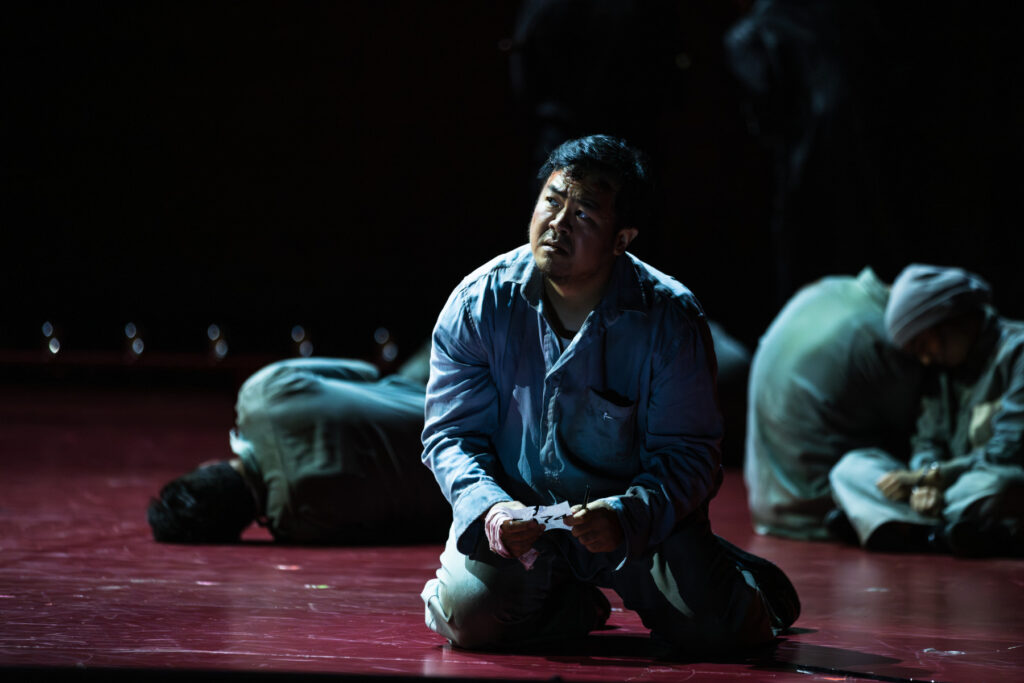To open its Fiftieth Anniversary Season, Glimmerglass Festival opted for a reliable potboiler, Puccini’s Tosca, but with a contemporary twist.
Rather than setting it in its scripted time period of June 1800, when the Kingdom of Naples’ reign over Rome was threatened by Napoleon’s invasion of Italy, director Louisa Proske and her creative team have transported the piece to the present day, aspiring to achieve resonance with the troubling storm clouds of encroaching totalitarianism. That this bold Konzept succeeds to a degree is owing to several imaginative designers, quite a starry cast, and a meticulously polished orchestra.
Michelle Bradley has all the goods to deliver a potent rendition of the title role: richly tinged spinto tone, even vocal production, a hint of sultry duskiness, generously searing top notes, and innately varied interpretive gifts. Ms. Bradley’s imperious entrance served notice that she was going to own the evening, and she certainly made good on that promise. This was a well-considered and fully rounded portrayal from this renowned soprano, even allowing for the fact that a handful of high notes came to some grief in Vissi d’arte and the Act III duet. Her final, hurled promise that she would meet her tormentor Scarpia before God, was thrilling in its visceral impact.

Veteran bass-baritone Greer Grimsley was every bit Ms. Bradley’s equal as a seasoned, bad-to- the-bone Baron Scarpia. There is no nuance of this driven, sadistic despot that eludes him, and at nearly seventy years old, Mr. Grimsley’s potent, laser-focused singing at full steam rang off the back wall with astounding power. At mid volume, in the upper middle range, If the voice did not always have the freshness of fifteen years ago, such musical passages were nevertheless well negotiated, musically and dramatically. This was an intense, laser-focused, indelible role traversal from a treasurable artist.
As Cavaradossi, Yongshao Yu did his youthful level best to keep up with his veteran co-stars, at first content to dazzle with bright, clarion high notes and rather impetuous delivery. Mr. Yu gradually came into his own with a splendid Vittoria, and an Act III that found him more concerned with dramatic values than volume. It has to be said that his is a solid technique, deployed intelligently to produce reliable vocalizing, but I yearned for a hint more Italianate sheen and spin.
Donghoon Kang was an uncommonly fine Angelotti, his distinctive bass-baritone possessed of an engaging warmth and expansive passion. Sergio Martinez was anything but the usual vocal caricature as the Sacristan, as he deployed his gorgeously dark, rolling bass to exceptional effect. Kellan Dunlap’s bright, easy tenor, and commanding stage presence served the character of Spoletta well. As Sciarrone, Luke Harnish sported a meaty baritone. In his brief appearance during the opening bars of Act III, treble Ian Clark’s solo was sweetly rendered. The chorus, both youth and adults, was well prepared by Katherine Kozak.

In the pit, Joseph Colaneri elicited a sumptuous reading from his fine musicians and maintained scrupulous coordination with his singers to ravish us with an evening of musical riches. Maestro Colaneri seems to have this repertoire in his very being, and this propulsive, persuasive account of Puccini’s lovably lurid opus was supremely captivating.
Stripped of the traditional scenic evocations of the church of Sant’Andrea della valle, the Farnese Palace, and the Castel Sant’Angelo, Team Tosca opted for a modern dystopian look.
The late great John Conklin’s set design was ably realized by his associate James Rotondo. Act I opens in what seems to be a church under renovation. Four sets of massive scaffolding are shrouded in diaphanous cloths, a small statue of the Virgin Mary is on a pedestal left surrounded by flowers, and a large painting facing upstage is down right. Black scrim conceals the back wall, but suggestions of red votive lights peep through.
Spoiler Alert: There are some giveaways ahead.

In an effective, if inexplicable visual, as the motley looking chorus begins to enter for the Te Deum, the drop cloths are torn off and the scaffolding struck. This reveals the first real burst of color in the form of a large crucifix over an altar that tracks almost menacingly to down center, prompting the crowd to gather around it in supplication, as the black backdrop falls to the floor and the bare backwall turns blood red. Unusual, but highly effective. Then things got curiouser and curiouser.
Scarpia’s “office” in Act II is set in a military bunker. Stage left there is Scarpia’s bed peopled momentarily by a pooped sex worker, and a padded anteroom leading to the torture chamber; an unadorned long table and a safe are center; and stage right is a dingy institutional bathroom with toilet, shower and sink. A heavy metal sliding door is the main entrance, suggesting it could withstand a nuclear attack. Just where are we?
To change to Act III, a priest and altar boy used the long table to celebrate the Eucharist, as the stagehands struck everything else but the toilet. Scarpia, “dead” on the bed, gets up and walks off. The bare stage is first populated by a group of prisoners, among whom is Cavaradossi. Left alone, he sings an ardent E lucevan le stelle, after which he is joined by Tosca. As they duet, the feel changes to that of a stage performance, with footlights upstage, behind which sit audience members on spaced out chairs, watching as the lights dim and the lovers are bathed in pink follow spots. Not unlike the final fantasy scene of Kiss of the Spider Woman.
This happiness can’t last, of course. Mario gets suitably shot down left, Scarpia, now “dead in bed” again is wheeled back on up center, and Tosca, left with nowhere to jump, runs to the bathroom (where she had sung Vissi d’arte), and uses the pistol she stole from Scarpia’s safe to end it all, sinking to the floor next to the toilet. The three bodies are in lighting specials forming a bloody Trinity as the back wall once again turns deep red.
Robert Wierzel devised a cornucopia of amazing lighting effects, from moody shadows to piercing brightness, to multihued decay, to (literally) spot-on clarity. Costumer designer Kay Voyce contributed a wonderful palette of crisp military uniforms, drab peasant and prisoner garb, and a beautiful mustard colored overcoat for the diva’s first entrance. I found Tosca’s second act costume too over the top, a blinding gold sequined gown with matching stole and handbag. She was supposed to be coming from singing a cantata! Was it with the Electric Light Orchestra? Tom Watson’s hair and make-up design was well suited to the characters, and I loved Tosca’s sunglasses in Act I. It was a welcome goof that she would wear them in a dimly lit church.
Director Louis Proske clearly had a vision that she wanted to communicate, and she brought it consistently to vibrant fruition. Whether it served Puccini as well as it served Proske could be debated. While she moved her forces about the stage with purpose and visual variety, I felt much more need to foster a sexual chemistry between Cavaradossi and Tosca, who seemed more like sparring high schoolers than mature romantic partners. There is always a risk updating a piece that refers to historic events. When the choristers sing in celebration of Napoleon’s victory, what does that mean in this context? Why does Tosca ask for passage to Civitavecchia? When places and events don’t jibe with the storytelling, the potential for distraction is great.
This Tosca took a big leap, and while she didn’t land squarely on both feet, she didn’t fall on her face either. Come for the glorious music, be prepared for quirky surprises, join in the buzz about this intriguing version, and wish the esteemed Glimmerglass Festival a Happy Fiftieth.
James Sohre
Tosca
Music by Giacomo Puccini
Libretto by Giuseppe Giacosaand Luigi Illica
Floria Tosca: Michelle Bradley; Mario Cavaradossi: Yongzhao Yu; Scarpia: Greer Grimsley; Cesare Angelotti: Donghoon Kang; Sacristan: Sergio Martinez; Spoletta: Kellan Dunlap; Sciarrone: Luke Harnish; Treble Solo: Ian Clark; Jailer: Jeremy Harr; Conductor: Joseph Colaneri; Director: Louisa Proske; Set Designer: John Conklin; Associate Set Designer: James Rotondo; Costume Designer: Kay Voyce; Lighting Designer: Robert Wierzel; Hair and Make-up: Tom Watson; Chorus Director: Katherine Kozak
Top image: Michelle Bradley as Floria Tosca and Yongzhao Yu as Mario Cavaradossi in the 2025 Glimmerglass Festival production of Tosca. Photo Credit: Brent DeLanoy/The Glimmerglass Festival